Robins Air Force Base
Robins Air Force Base (IATA: WRB, ICAO: KWRB) is a major United States Air Force installation located in Houston County, Georgia, United States. The base is located just east of and adjacent to the city of Warner Robins, 18 mi (29 km) south-southeast of Macon and approximately 100 mi (160 km) south-southeast of Atlanta, Georgia. The base is named in honor of Brig Gen Augustine Warner Robins, the Air Force's "father of logistics".[2]
| Robins Air Force Base | |||||||
|---|---|---|---|---|---|---|---|
| Warner Robins, Georgia in the United States of America | |||||||
 A C-5 Galaxy undergoing modifications during 2011 at Warner Robins Air Logistics Center. | |||||||
 | |||||||
 Robins AFB Location in the United States | |||||||
| Coordinates | 32°38′24″N 083°35′30″W | ||||||
| Type | US Air Force Base | ||||||
| Site information | |||||||
| Owner | Department of Defense | ||||||
| Operator | US Air Force | ||||||
| Controlled by | Air Force Materiel Command (AFMC) | ||||||
| Condition | Operational | ||||||
| Website | www.robins.af.mil | ||||||
| Site history | |||||||
| Built | 1941 – 1942 | ||||||
| In use | 1942 – present | ||||||
| Garrison information | |||||||
| Current commander | Colonel Brian R. Moore | ||||||
| Garrison | 78th Air Base Wing (Host) | ||||||
| Airfield information | |||||||
| Identifiers | IATA: WRB, ICAO: KWRB, FAA LID: WRB, WMO: 722175 | ||||||
| Elevation | 89.6 metres (294 ft) AMSL | ||||||
| |||||||
| Source: Federal Aviation Administration[1] | |||||||
Robins AFB is the home of the Air Force Materiel Command's Warner Robins Air Logistics Center (WR-ALC) (FLZ) which is the worldwide manager for a wide range of aircraft, engines, missiles, software and avionics and accessories components. The commander of WR-ALC is Brigadier General John C. Kubinec.[3] It is one of three Air Force Air Logistic Centers, the others being Oklahoma City Air Logistics Center (OC-ALC) at Tinker Air Force Base, Oklahoma and Ogden Air Logistics Center (OO-ALC) at Hill Air Force Base, Utah.
The host unit at Robins AFB is the 78th Air Base Wing (78 ABW) which provides services and support for the Warner-Robins Air Logistics Complex and its tenant organizations. The Wing and Installation Commander of Robins Air Force Base is Colonel Brian R. Moore.[4] The Wing Vice Commander is Colonel Katrina C. Stephens.[5]
History

The War Department, in search of a site for an Army Air Corps Depot, selected the sleepy whistle-stop town known as Wellston, Georgia, 18 miles south of Macon. Army Colonel Charles Thomas, originally from Atlanta, landed at the Herbert Smart Airport near Camp Wheeler near Macon in October 1941 to oversee the building of the location which would later become the home to Wellston Air Depot at Robins Field (later to become Robins AFB).[6]
It was Col. Thomas who chose the name "Robins" for his mentor Brig. Gen. Augustine Warner Robins. Brig. Gen. Robins is considered the 'father of logistics' for his system of cataloging supplies and materials. He had a lengthy military career prior to becoming the chief of the Air Corps Materiel Division. Robins traveled in China disguised as a millionaire tourist, collecting intelligence for the Army. He also went to Mexico where he served under Gen. John J. Pershing in the Army's campaign against Pancho Villa. He trained during World War I to become a pilot earning his wings in June 1918. He didn't get to see combat because the war was ending. Robins suffered a near-fatal plane crash in 1921 in which his jaw and arm were severely broken. Brig. Gen. Robins died of a heart attack on Father's Day, 16 June 1940 at Randolph Field, Texas, while he was Commandant of the Air Corps Training Center.[6]
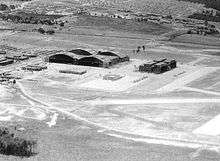
After World War II, when the Air Force closed down its maintenance depots at the former Brookley AFB in Mobile, Alabama and the former Olmsted AFB in Middleton Township, Pennsylvania, Robins AFB assumed the workload of these depots. Some Robins AFB SAC units went to Guam or Vietnam during the Vietnam War and took part in many of the bombing missions. Maintenance teams from Robins frequently traveled to Southeast Asia to repair severely damaged aircraft. Robins AFB eventually managed the Lockheed C-141, C-7, and the F-15 Eagle as well as modifying the C-130s to the gunship configuration.
Robins played a key role in the Vietnam War (1964–73), supplying troops and materiel through the Southeast Asian Pipeline and modifying AC-119G/K and AC-130 gunships. Also playing a role were the C-141, the C-130, the C-123, and the C-124 cargo aircraft—all maintained at Robins. In 1973 these same C-141s supported the resupply of Israel in the Yom Kippur War. In October 1983, C-130s from Robins supported U.S. forces in the invasion of Grenada.
Between 1977 and 1981, Robins was the air base used by former President Jimmy Carter during his tenure on visits to his hometown of Plains. SAC's B-52s left Robins in 1983 leaving the 19th Wing as the sole SAC unit on the base with its KC-135s.
Modern era
In 1990–91, during the Persian Gulf War, Robins provided record numbers of parts, repairs, and personnel to coalition forces in the Persian Gulf. Robins-maintained F-15 Eagles and the E-8 Joint STARS played key roles in defeating the Iraqi military powers. In March–June 1999, during Operation Allied Force, the same employees and weapon systems played a decisive role in defeating the forces of the Yugoslavian president Slobodan Milosevic.
In 1996, the Georgia Air National Guard's 116th Fighter Wing at Dobbins AFB relinquished their F-15 aircraft and moved to Robins, transitioning to B-1 Lancer bombers and being redesignated as the 116th Bomb Wing. That same year, the former 93rd Bomb Wing at Robins was reactivated as the 93rd Air Control Wing with the E-8 Joint STARS aircraft. In 2001, the B-1 bombers left Robins AFB and the Georgia Air National Guard entered into a merged Active-Guard "associate" wing arrangement in the Joint STARS mission with the active Air Force, with the Air National Guard holding lead responsibility as the 116th Air Control Wing.
The Warner Robins Air Logistic Complex and Robins AFB form the largest single industrial complex in the State of Georgia. The 23,000 civilian employees have an annual payroll over $1 billion. The Logistic Complex manages and overhauls the F-15, C-5 Galaxy, C-130 Hercules, and the AC-130 gunships—and all of the Air Force's helicopters. In addition, the Complex also supports the C-17 Globemaster III and U-2 aircraft.
Until June 2008, Robins was also the home of the KC-135s of the 19th Air Refueling Group, when the unit was inactivated, then reactivated a month later as the 19th Airlift Wing at Little Rock AFB, Arkansas. The E-8s of the 116th Air Control Wing continues to operate at Robins as a combined Regular Air Force and Georgia Air National Guard air control wing, and the headquarters of the Air Force Reserve Command is also located on the base. The metropolis of Warner Robins, Georgia has grown in proportion to become the sixth largest city in Georgia.
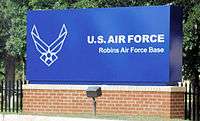
The C-27J Schoolhouse, operated by L-3 Link, officially began classes at Robins Air Force Base, Georgia in September 2008. L-3 Link (a subsidiary of L-3 Integrated Systems) operates the official C-27J schoolhouse at the Georgia Department of Defense's Fixed Wing Flight Facility at Robins AFB. This world class flight facility includes training classrooms, computer learning center, a large 100 person auditorium with high-definition audio-visual equipment, flight planning and fight operations areas. The facility also houses the resident Government Flight Representative and Aviation Program Team assigned to the C-27J contract. Fixed Wing Flight Facility Robins AFB is also home of Hotel Company, 171st Aviation Regiment, Georgia Army National Guard, flying the cargo delivery Short C-23 Sherpa.
On April 1, 2016, an EF-1 tornado ripped through the northeast corner of Centerville and continued over Robins Air Force Base, ripping off hangar roofs.
Major commands
- Air Service Command, 22 July 1942
- Redesignated: Army Air Forces Materiel and Services Command, 17 July 1944
- Redesignated: Army Air Forces Technical Service Command, 31 August 1944
- Redesignated: Air Technical Service Command, 1 July 1945
- Redesignated: Air Materiel Command, 9 March 1946
- Redesignated: Air Force Logistics Command, 1 April 1961 – 1 July 1992
- Air Force Materiel Command, 1 June 1992 – present
- Air Force Reserve Command, 17 February 1997–present
Major units assigned
|
|
Role and operations
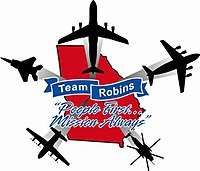
Warner Robins Air Logistics Complex
Has worldwide management and engineering responsibility for the repair, modification and overhaul of the F-15 Eagle, C-130 Hercules, C-17 Globemaster III, and C-5 Galaxy, C-5M Super Galaxy, Boeing F-15E Strike Eagle, RQ-4A Global Hawk, Sikorsky HH-60G Pave Hawk aircraft. In addition to these weapon systems, the ALC has worldwide management responsibility for the U-2S Dragon Lady, all Air Force helicopters, all special operations aircraft and their peculiar avionics systems. The center also provides logistic support for all the C-17 Globemaster III, Air Force missiles, vehicles, general purpose computers, and many avionics and electronic warfare systems used on most Air Force aircraft.
78th Air Base Wing
The wing provides support for Robins AFB and its 39 associate units. Responsible for logistics readiness, medical, civil engineer, security, comptroller activities, contracting, morale and welfare, mission support, public affairs, legal civilian personnel, environmental management, fire emergency services, and emergency management for the installation.
- 78th Mission Support Group
- 78th Medical Group
- 78th Civil Engineer Group
- 78th Security Forces Squadron
- 78th Operations Support Squadron
- 78th Comptroller Squadron
- 78th Communications Directorate
330th Aircraft Sustainment Wing
The wing provides weapon system logistics support, oversees unscheduled and programmed depot maintenance, and manages modification efforts for the Air Force's fleet of C-5, C-130, C-17, F-15, U-2, and E-8C Joint STARS aircraft, Global Hawk,Distributed Common Ground System (DCGS), MC-130, HC-130 and various special operations combat search and rescue aircraft and helicopters to include AC-130H/U,MC-130E/H/P/J, EC-130J, MH-53J/M, HH-60G, UH-1N,TH-1H, and HC-130P/N/J. In addition the wing is the engineering authority for all the aircraft above except for Boeing C-17A, RQ-4A/B Global Hawk, and E-8C.
- 330th Aircraft Sustainment Group
- 560th Aircraft Sustainment Group
- 580th Aircraft Sustainment Group
- 730th Aircraft Sustainment Group
- 830th Aircraft Sustainment Group
402d Maintenance Wing
Provides depot maintenance, engineering support and software development to major weapon systems (F-15, C-5, C-130, C-17 and SOF aircraft) to support peacetime maintenance requirements, wartime emergency demands, aircraft battle damage repair and a ready source of maintenance of critical items.
- 402d Aircraft Maintenance Group
- 402d Commodities Maintenance Group
- 402d Electronics Maintenance Group
- 402d Maintenance Support Group
- 402d Software Maintenance Group
- 402d Business Development & Partnership
542d Combat Sustainment Wing
The 542 CSW works by designing, acquiring, installing, and sustaining electronic warfare, avionics, support equipment, vehicles, missiles, and weapons. Responsible for life-cycle management of over 800 systems valued at $56.2B. Manages $4.21B in executable funds and $8B in contracts to foster improvement in the agile logistics environment. Directly responsible for management of seven ACAT II programs. Programs include: electronic warfare, airborne and ground communication, navigation, precision attack systems, weapons and missiles, support equipment (SE),Automatic Test Systems (ATS), industrial equipment, vehicles, Basic Expeditionary Airfield Resources (BEAR),Air Force life support systems, armament, specialized programs, and supply chain management activities for WR-ALC.
- 542d Combat Sustainment Group
- 562d Combat Sustainment Group
- 642d Combat Sustainment Group
- 742d Combat Sustainment Group
- 752d Combat Sustainment Group
- 762d Combat Sustainment Group
- 782d Combat Sustainment Group
Tenant Units
- Air Force Reserve Command Headquarters
- 492nd Special Operations Wing (Detachment 1)
- 461st Air Control Wing [ USAF ]
- 116th Air Control Wing [ Georgia ANG
- 689th Combat Communications Wing
- Army Aviation Support Facility Robins AFB
- Hotel Company, 171st Aviation Regiment (C-23 TAC)
- C-27J Aircraft Qualification Schoolhouse
- 94th Aerial Port Squadron
- 367th Recruiting Group
- Robins NCO Academy
- Air Force Metrology and Calibration Program Office (AFMETCAL)
Based units
Flying and notable non-flying units based at Robins Air Force Base.[7][8][9]
Units marked GSU are Geographically Separate Units, which although based at Robins, are subordinate to a parent unit based at another location.
United States Air Force
|
Air Force Materiel Command (AFMC)
|
Air Combat Command (ACC)
Air Force Space Command (AFSC)
Air Force Reserve Command (AMRC)
Air National Guard (ANG)
United States Army
Army National Guard (ARNG)
Defence Logistics Agency
|
Museum of Aviation
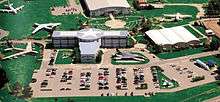
Near the base is the Museum of Aviation,[10] begun in 1981, has four major structures on forty-three acres and ninety historic aircraft. The museum is also home to the Georgia Aviation Hall of Fame which honors outstanding Georgians prominent in aviation.
The 93 aircraft and missiles on display include a B-52, SR-71, a Marietta, Georgia-built B-29, and a specially modified C-130 Hercules that was used in Operation Eagle Claw the failed Iran-hostage rescue mission.
It has become a major regional educational and historical resource that hosts more than 500,000 visitors annually.
Geography
The base is located in northeastern Houston County, bordered to the west by the city of Warner Robins. The Ocmulgee River is to the east. It is 17 miles (27 km) south of Macon.
Demographics

The base is the single largest industrial complex in Georgia, employing a workforce of over 25,584 civilian, contractor, and military members.[11]
As of the 2010 census, the residential population on the base was 1,170,[12] in 231 households, 203 of which were families. There were 245 housing units. The racial makeup of the base residents was 72.6% White, 18.5% Black or African American, 0.3% Native American, 2.1% Asian, 0.6% Pacific Islander, 0.6% some other race, and 5.3% from two or more races. Hispanic or Latino of any race were 9.2% of the population.[13]
72.3% of the households had children under the age of 18 living with them, 75.3% were headed by married couples living together, 7.4% had a female householder with no husband present, and 12.1% were non-families. 11.7% of all households were made up of individuals, and none had someone living alone who was 65 years of age or older. The average household size was 3.33, and the average family size was 3.62.[13]
28.4% of the residential population were under the age of 18, 38.4% were from 18 to 24, 27.5% were from 25 to 44, 5.2% were from 45 to 64, and 0.5% were 65 years of age or older. The median age was 21.5 years. For every 100 females, there were 157.1 males, and for every 100 females age 18 and over, there were 196.1 males.[13]
For the period 2011-15, the estimated median annual income for a household in the base was $62,125, and the median income for a family was $62,375. Male full-time workers had a median income of $28,529 versus $35,500 for females. The per capita income for the base was $20,122. About 7.8% of families and 8.2% of the population were below the poverty line, including 11.4% of those under age 18 and none of those age 65 or over.[14]
Tornadoes
As with the adjacent city of Warner Robins, tornadoes have continually plagued the base since its inception with the 1950s seeing at least two catastrophic tornadoes strike the area. The first one occurred on April 30, 1953, when an F4 tornado with winds of over 200 mph hit the base, killing 18 people and injuring 300 more.[15][16] Just ten months later on March 13, 1954, a long-tracked F1 tornado struck the base, killing one and injuring five.[17] To date, at least seven tornadoes have hit the base and the surrounding area.[18]
See also
References
![]()
![]()
- "Airport Diagram – Robins AFB (KWRB)" (PDF). Federal Aviation Administration. 12 September 2019. Retrieved 29 September 2019.
- Krakow, Kenneth K. (1975). Georgia Place-Names: Their History and Origins (PDF). Macon, GA: Winship Press. p. 190. ISBN 0-915430-00-2.
- https://archive.today/20120719062359/http://www.af.mil/information/bios/bio.asp?bioID=7789. Archived from the original on 19 July 2012. Missing or empty
|title=(help) - "Col Buhler USAF Bio". Robins.af.mil. Archived from the original on 25 February 2012. Retrieved 7 January 2012.
- "Col Bean USAF Bio". Robins.af.mil. Archived from the original on 14 February 2012. Retrieved 7 January 2012.
- The Father of AF Logistics: The Life and Times of Brig. Gen. Augustine Warner Robins (RCS HAF-CHO(AR) 7101); William Head, PhD; Office Of History, WR-ALC, Air Force Logistics Command, Robins AFB, GA, 1991
- "Units". Robins AFB. Retrieved 29 September 2019.
- "Military Intelligence Detachment (JSTARS)". US Army Intelligence and Security Command. US Army. 19 June 2019. Archived from the original on 19 September 2012. Retrieved 29 September 2019.
- Moriarty, Kristin (7 May 2019). "Defense Logistics Agency at Robins Air Force Base: Director of Distribution shares insight". Defense Logistics Agency. Retrieved 29 September 2019.
- Museum of Aviation Official site at Robins AFB
- "Robins AFB". www.militarybases.us. Retrieved 20 June 2018.
- "Geographic Identifiers: 2010 Demographic Profile Data (G001): Robins AFB CDP, Georgia". American Factfinder. U.S. Census Bureau. Retrieved 19 May 2017.
- "Profile of General Population and Housing Characteristics: 2010 Census Summary File 1 (DP-1): Robins AFB CDP, Georgia". American Factfinder. U.S. Census Bureau. Archived from the original on 13 February 2020. Retrieved 19 May 2017.
- "Selected Economic Characteristics: 2011-2015 American Community Survey 5-Year Estimates (DP03): Robins AFB CDP, Georgia". American Factfinder. U.S. Census Bureau. Archived from the original on 13 February 2020. Retrieved 19 May 2017.
- Mackie, Matt. "Midstate residents remember EF4 tornado in Warner Robins 65 years ago". WGXA. Retrieved 13 July 2018.
- National Weather Service (February 2020). Georgia Event Report: F4 Tornado (Report). National Centers for Environmental Information. Retrieved 4 June 2020.
- "Georgia F1". Tornado History Projects. Storm Prediction Center. Retrieved 11 July 2020.
- "Tornado History Project: Houston County, Georgia". Tornado History Projects. Storm Prediction Center. Retrieved 11 July 2020.
- Ravenstein, Charles A. Air Force Combat Wings Lineage and Honors Histories 1947–1977. Maxwell Air Force Base, Alabama: Office of Air Force History 1984. ISBN 0-912799-12-9.
- Mueller, Robert, Air Force Bases Volume I, Active Air Force Bases Within the United States of America on 17 September 1982, Office of Air Force History, 1989
- Shettle, M. L. (2005), Georgia's Army Airfields of World War II. ISBN 0-9643388-3-1
- Ryan Winkle. 4\25 BSTB Fort Richardson Alaska: STP-21-1-SMCT: Department of the Army- ATSE-DOT-DD: Directorate of Tranining:320 Engineer Loop-Suite 336-Fort-Leonard-Wood-MIssouri-65473-8929:Joint-Engineer-Operations:Field-Manual:5-34
External links
| Wikimedia Commons has media related to Robins Air Force Base. |
- Resources for this U.S. military airport:
- FAA airport information for WRB
- AirNav airport information for KWRB
- ASN accident history for WRB
- NOAA/NWS latest weather observations
- SkyVector aeronautical chart for KWRB

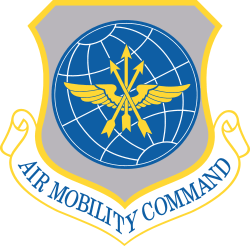

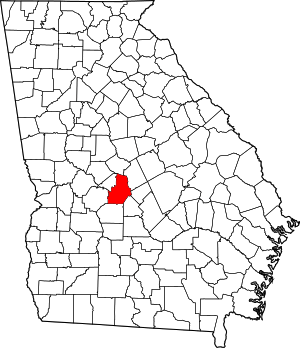

.svg.png)